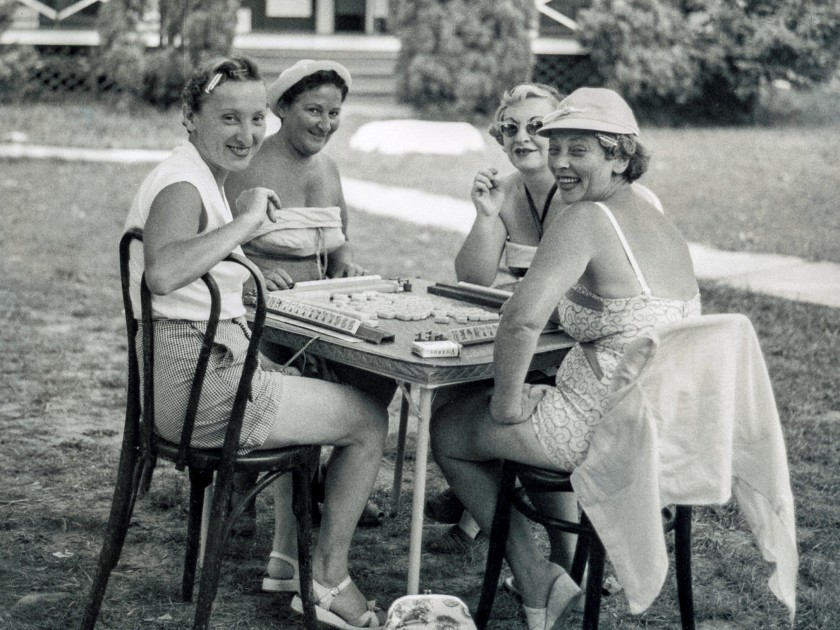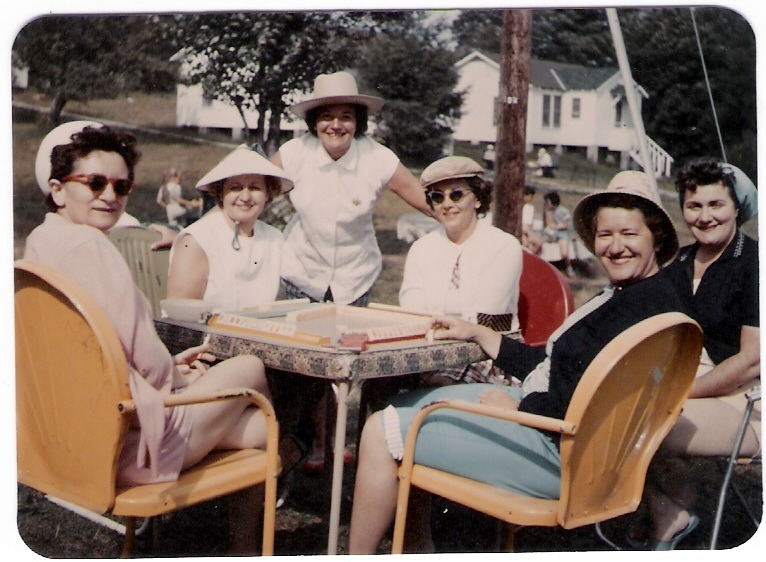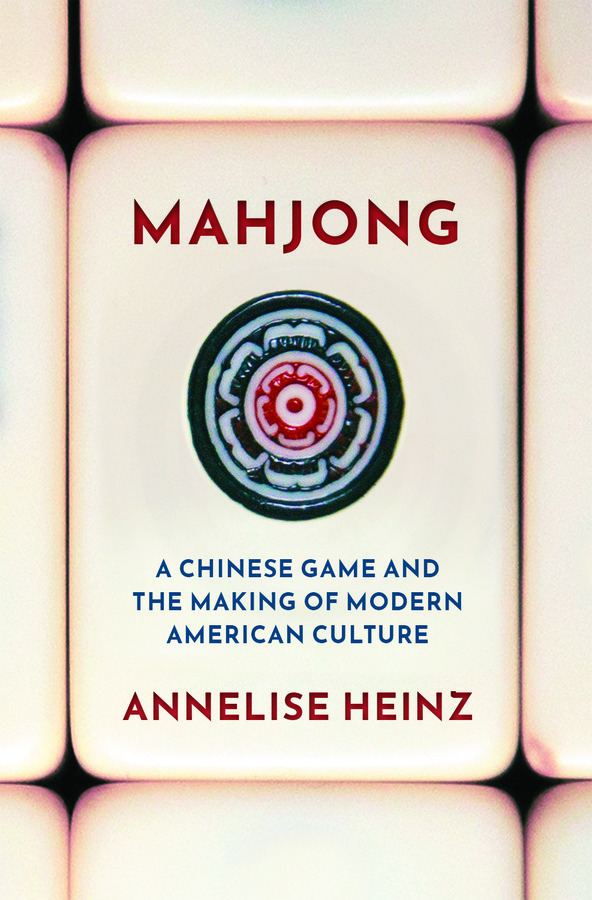
At an outdoor mahjong game in 1955, these players and their friends met and vacationed every summer at Green’s Lakeside Hotel, Port Jervis, New York, near the influential Catskills region. Games took place on the lawn between the families’ bungalows. The women’s swimwear and hairpins speak to the leisured tempo of summertime vacation communities. Courtesy of Lorna Drake, Freudy Photos Archives, LLC. From MAHJONG: A Chinese Game and the Making of Modern American Culture by Annelise Heinz
For over a decade, the Feinstein family joined thousands of other mostly middle-class Jewish families on an annual summer migration to the Catskills. Beginning in 1958 with a very small bungalow colony with neighbors from their apartment building, they joined a larger community two years later. Their move up in Catskills accommodations mirrored their moves to larger city apartments and, in 1963, to a suburban house near the coveted “shul with a pool.” After traveling a couple of hours north by car with her husband, Martin, and two children from their home in Queens, Gloria Feinstein set up their cottage, one of a group of twenty-four bungalows, where she would spend the summer with her children, away from the sweltering heat of the city. Martin Feinstein then went back to Queens, continuing his work as an attorney during the week and returning to the cottage to join his family on the weekends. With her husband away and their children at day camp, Gloria’s household responsibilities relaxed. Meals became simpler. She could assume her children were safe and entertained. She was surrounded by acquaintances whom she saw only at the bungalow colony, all following their own similar rhythms. Although there were constraints — the twenty-four bungalows shared one washing machine — domestic expectations were lower there than at home. In the afternoons, circulating games at mahjong tables filled the small patches of lawn between the cottages. The clicking of mahjong tiles was one of the sounds of summer. Families ate according to the same established dinnertime and, after Gloria had made a simple supper and the children were in bed, she joined her neighbors in the colony’s “casino,” and played mahjong every weeknight. Gloria’s daughter Barbara later remembered women playing mahjong “all the time. Really all the time” — except, however, when the husbands returned. “When the men were there,” Barbara recalled, the wives “were there for their men.”

Stella Prebler, Pearl Abrams, Pearl Feinstein (standing), Shirley Friedman, Ruth Feinberg and Dottie Cowen (L‑R) gathered for mahjong at Gold-Dan’s Lake House and Cottages. Located in between Monticello and Liberty in the Catskills of New York in the mid-1950s, the cottages were also near children’s overnight camps. The cigarettes, table covering, and colorful tile racks seen here were ubiquitous at American mahjong games. Courtesy of Harvey Abrams.
The Catskills Mountain region became an iconic place for upwardly striving Jewish Americans to grab hold of the American good life in a distinctly Jewish environment. “The Borscht Belt,” as it was commonly known, was not only the largest Jewish resort area, but also the world’s largest community of contiguous resorts. The core of the “Jewish Alps” covered 250 square miles of hills and farmland about 100 miles northwest of New York City. Having evolved in the first half of the twentieth century, the Catskills region hosted an unprecedented efflorescence of Jewish leisure culture after World War II. At its peak in the 1950s and 1960s, vacation communities dotted the landscape, with hundreds of options for lodging available, from cramped rooming houses to cozy bungalow colonies to luxurious hotels. Millions of Americans spent time in the area, often returning summer after summer, and the hotels created an entertainment circuit that honed Jewish humor into a national art. From the war years through the early 1960s, the middle-class milieu of bungalow colonies in particular created a venue for female leisure with its daily rhythms of eased domesticity. By the 1950s and 1960s, women playing mahjong and cards dotted the resort terrain. “Everywhere! They were like, everywhere,” a former Catskills hotel waiter remembered.
During the early twentieth century, accommodations slowly evolved to become more comfortable as growing numbers of New Yorkers escaped summer heat and overcrowding by going to the mountains. By the 1930s, a kind of hybrid accommodation of small outbuildings or rooms with a shared farmhouse kitchen provided an affordable and increasingly popular option during the Depression. The cottages were known by their Yiddish name kuchalayn, literally meaning cook-alone — or more accurately for these crowded kitchens, cook-for-yourself.
Going to the country was simply “what women did.” It was also a demonstration of status that became increasingly pronounced as accommodations continued to diversify. By the 1940s, those who could afford it generally preferred to stay at a bungalow colony, a structural cousin to the kuchalayn. (To add confusion, the bungalow colonies could also be referred to as kuchalayn.) A bungalow colony generally provided small fully equipped cottages with a recreation building known as “the casino” — home to mahjong games during the week and couples’ dancing on the weekends. Colonies could host “a great stir of activity, even organizing committees during the first few weeks to adjudicate disputes among the children and plan soft-ball and mah-jongg tournaments.” Women provided much of the labor necessary to keep the community infrastructure and their families going, but there was still more time for relaxation.
During the early 1950s through the mid-1960s, the Catskills experienced enormous growth. The end of wartime shortages brought an explosion of renovation to meet pent-up demand. Each year, legions of visitors descended on the region, with estimates ranging from one to over two million guests. The traffic spurred new expressway construction, easing the driving commute and replacing the train. Class was a significant, though not clear-cut, distinction between the increasingly luxurious hotels and the more communal bungalow colonies. The “big hotels” were in a class of their own, though they were far outnumbered by small family hotels. Among the trendsetters, Grossinger’s and the Concord led the pack. Both hotels advertised mahjong tournaments as part of their highly organized schedule of activities, with visiting experts from the National Mah Jongg League. This “supernova period” in the Catskills, as historian Phil Brown dubbed it, directly coincided with the flourishing of mahjong culture.
Where Jewish women relaxed together, mahjong was very often present, both among those who traveled to the Catskills and those who did not.
Each kind of environment developed its own tempo of leisure. The “pleasure dome” hotels catered more frequently to couples’ short-term stays and mahjong was present more at the pools and tournaments than scattered everywhere as it was on the lawns between bungalows. Small hotels shared the colonies’ culture of weekend-commuting husbands. To commentators like David Boroff, who decried women’s influence on modern Jewish culture, the Catskills could appear to provide women with “total leisure” and regression to an adolescent “camaraderie-of-the-girls” — acquired on the backs of their poor working husbands, whom he likened to slaves. From a different perspective, the summers apart provided both parents some respite from cramped quarters and family demands amid ongoing, though reduced, labor. Across the board, the resort communities allowed family members to pursue independent recreation, for women to play hours of mahjong while children were otherwise occupied.
The Catskills profoundly shaped an evolving American Jewish culture, but the region hosted diversity among Jews, too. Amid the dominant culture of second-generation middle-class Conservative suburbanizing urbanites was a significant minority of working-class kuchalayn residents and Orthodox bungalow colonies. In the late 1940s, Ruth Milch seasonally left her full-time work as a keypunch operator in Brooklyn, while her husband drove back and forth from his job as a grocer middleman. Refugees from the Holocaust brought their families, too.
Where Jewish women relaxed together, mahjong was very often present, both among those who traveled to the Catskills and those who did not. As part of the growing middle-class ethos, a leisured domesticity spread and diversified. Women played mahjong at beach clubs on Long Island, at community swimming pools in the Bronx and New Jersey, at Jewish country clubs in Atlanta, and resorts by Lake Michigan. In the late 1950s, a new landscape of leisure developed through beach clubs, particularly on Long Island. Influenced by Catskills culture, beach clubs were closer to home and therefore more amenable to the family life that 1950s culture celebrated. Families could pay a summer membership for a living-room style cabana to stay in or a more affordable locker for their belongings. At $200 to $800 for three months, the cost was comparable to that of a bungalow colony but allowed for husbands to join their families on weekday evenings. Although most went back and forth to their homes overnight, women’s culture still flourished during the day as children attended day camps. As the New York Times described it, the “heart of the clubs is the card game, the mah-jongg, the chit-chat in front of the cabanas.” Barbara Dellon’s nuclear family relished their summers in the Catskills, but her grandmother played at a Long Island beach club and avoided what she saw as dreary bungalow colonies. Mahjong was her daily beachside activity, despite the sand that eventually encrusted her set.
Summer communities were the epicenters of mahjong’s ripples into neighborhoods. Women could learn the game over one or two summers and return to their new communities with skills to share. Ruth Unger, who would later serve for over three decades as president of the National Mah Jongg League, “really learned” the game at “a bunch of little places” in the Catskills after the war and brought her knowledge to her Brooklyn apartment building with other young mothers. The New Yorkers who came to the Catskills, along with smaller numbers from Detroit, Boston, and Baltimore, used neighborhood networks to build summer communities and took some elements of Catskills culture with them when they returned home. In 1960 the League responded to players’ desires for more time to practice the year’s new rule card before the summer vacationing months of mahjong by bumping up the release date from the end to the beginning of April.
Playing mahjong in the Catskills became a signature part of growing up as Jewish and female in 1950s New York. One woman fondly described her kuchalayn as “the shtetl revisited or, more accurately, transformed and transported to a cleaner, safer, place.” In this remembered idyllic and specifically Jewish context, she “learned how to swim, find Indian arrowheads, dance, play Mah Jongg, kibitz, and had my first real crush and my first real heartbreak there.” Rooted in a sheltered culture of the 1950s, the Catskills helped many baby boomers come of age.

MAHJONG: A Chinese Game and the Making of Modern American Culture by Annelise Heinz
From MAHJONG: A Chinese Game and the Making of Modern American Culture by Annelise Heinz. Copyright © 2021 by Oxford University Press and published by Oxford University Press. All rights reserved.
Annelise Heinz is an assistant professor of history at the University of Oregon. Her work has been featured on National Public Radio and international Chinese television. She has lived and played mahjong in the United States and Southwestern China.